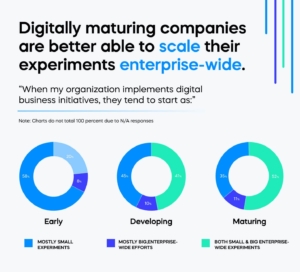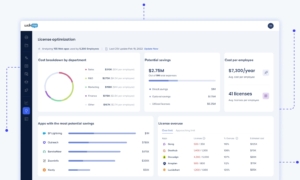Executing a digital transformation initiative is a major undertaking for even the most experienced CIO. But the work doesn’t end there. Creating meaningful KPIs can be an even more taxing experience.
Measuring digital transformation progress is such a challenge that many companies avoid monitoring it altogether. They get so caught up in the excitement of launching a groundbreaking digital transformation initiative, that drier matters like KPIs get pushed to the background.
Without a framework to measure digital transformation, success will evade you
Unfortunately, this an oversight that cripples many transformations before they get off the ground. Our State of Digital Adoption 2022-2023 report found that enterprises failed to meet 59% of their digital projects KPIs in the past year.
But with a developed system for monitoring progress and identifying weak points, it’s possible to course-correct along the way to achieve greater success and achieve organizational transformation.
Pinning down metrics to measure digital transformation is a challenge. When digital transformation looks different for all organizations, there are no universal metrics that apply to all enterprises.
Where some companies are introducing digital systems for the first time, others are migrating from legacy systems to more sophisticated cloud-based platforms. Still, others are adding new apps and tools in a piecemeal fashion to supplement their existing digital activities.
Moreover, digital transformations can take place on an enterprise-wide scale or within a particular department. The lack of consistency in digital transformation initiatives makes creating KPIs a challenge.
The best KPIs to measure digital transformation progress
There are many ways to assess the progress and efficacy of your digital transformation efforts. Here, we’ll cover five important metrics.
- Measure the number of users relative to the number of licenses purchased
- Analyze the breadth and limitations of usability
- Count the number of processes performed on new software
- Productivity indicators
- Amount of new revenue attributed to digital investments
1. Measure the number of users relative to the number of licenses purchased
One way to measure the effectiveness of your digital undertakings is by comparing the number of licenses you purchased to the number of employees who are actually utilizing the software.
This measurement gives you a basic sense of the adoption rate of your software investment.
For instance, if you see that 90% of your licenses are being used, you can assume that the tool has been adopted. If just 30% of your licenses are being used, lack of digital adoption is an obvious barrier.
But if you want to truly understand how your investments are being used to promote your digital strategy, you’ll want to take a closer look at digital adoption.
2. Analyze the breadth and limitations of usability
Measuring exactly how your digital tools are being used will give you a clearer picture of how well your employees have adopted the tools and actually achieve meaningful benefits.
To do this, you’ll need a solution that enables you to view the user journey and analyze where bottlenecks and friction occur. WalkMe’s Digital Adoption Platform (DAP) provides such information via its Insights layer.
With Insights, you receive the full picture of adoption, which is one of the strongest indicators of overall digital transformation success. You can see where each individual user struggles in processes, which features are being underutilized, and how to improve usability.
3. Count the number of processes performed on new software
In addition to understanding the overall level of adoption and usability, you’ll want to know how many processes are being performed on your new software. This will give you an idea of how much value your software investment is bringing.
Realizing that few processes are being utilized can indicate a couple of different things. One is that the tool itself isn’t as relevant to the needs of your employees as you initially thought. The other possibility is a lack of digital adoption.
If this is the case, Insights from DAP can pinpoint the reason why. If poor usability is standing in the way, insights into the user journey can show you areas to simplify processes, provide greater training, or introduce automation or other targeted interventions.
4. Productivity indicators
Digital transformation is not a standalone initiative. Each digital investment you make should support the broader goals of your business strategy.
There are many ways to measure the impact of your digital transformation on your overall strategy. One of them is productivity, which is generally understood as the volume or value of outputs relative to the time and resources invested.
For example, if you invested in a digital tool to support customer support, you can measure how many more support tickets your team was able to handle since implementing the new system.
Like what you’re reading? Subscribe to the blog for fresh insights delivered right to your inbox!
5. Amount of new revenue attributed to digital investments
Similar to measuring productivity, you can measure how much your digital investments influence revenue.
For example, if you introduce automation into your customer journey, you can track how many prospects interacted with the tools and compare how many among them became paying customers.
Internally, you can see how various digital tools support efforts to bring in more business or improve operational efficiency.
Focus on the right metrics and guide your initiative to success
Digital transformation may vary tremendously from organization to organization, but there are some common metrics you can depend on to measure the success of digital initiatives.
Success requires consistent monitoring and course-correction based on what you find out. A reliable analytics system that provides clear insights on platform usability is fundamental to understanding key metrics like usability and adoption.
No matter which metrics are most important to you, the first step to achieving the ROI you set out for is determining how to measure digital transformation.
Which factors impact the choice of KPIs
The above metrics are among the most fundamental to implement during any digital transformation effort, but they are not the final word on KPIs.
A number of other factors can affect the metrics that are chosen, including:
The goals of the digital transformation program. The stated goals of a transformation effort will be the primary areas to focus on when developing metrics. These goals should be quantifiable, measurable, and they should be directly tied to improving specific business outcomes.
External circumstances. Today’s business environment is continually changing, and those changes often dictate the direction of digital transformation efforts. Since the modern business world is so fast-paced, enterprise transformation programs should stay adaptable and agile as much as possible. This also means that measurements themselves should be ready to adapt to external circumstances if needed.
Which technology is being adopted. In most cases, digital transformation involves digital adoption, which is why digital adoption metrics should be prioritized. Measuring digital adoption helps organizations improve employee productivity, software utilization, and the ROI of their technology efforts.
At the end of the day, digital transformation is aimed at helping an organization adapt and thrive in the digital economy, so it only makes sense that digital transformation programs themselves adhere to best practices that support that aim. The more adaptable and responsive that digital transformation leaders are when it comes to their own initiatives – including the way they measure and evaluate their programs – the more successful their programs will be.
Of course, success does not just depend on the execution of a digital transformation, but also on its scope and direction.
How to set the right digital transformation agenda
Since measurements will be focused on understanding and improving the goals of the transformation program, it is important to have a clear set of “strategic guardrails” when designing a transformation agenda.
That is, business leaders should create a well-defined set of goals for the transformation effort, rather than simply purchasing and deploying new technology in an effort to stay modern. IT modernization is an important piece of the digital transformation puzzle, of course, but it is only part of the overall purpose of digital transformation.
Explore the biggest challenges that hinder digital adoption and find out how to overcome these hurdles with cutting-edge solutions in the WalkMe special edition of Digital Adoption for Dummies.
Here are a few common aims that organizations pursue as part of their transformation programs, which then, in turn, form the basis for metrics and measurements:
Digital maturity
Digital maturity is a scale that defines an organization’s overall digital capabilities. It refers to the digital tools and the IT infrastructure of an organization, as well as other important factors that impact those capabilities, such as employee skill levels, the integration of the digital workplace, and how much software is being utilized.
There are a number of different models of digital maturity, but they generally are built upon a simple scale.
At the bottom of the scale lies the least digitally mature organizations, with little or no digital capabilities. Organizations lack the right tools, and the tools they do have are poorly integrated and implemented. Employees, likewise, don’t have the required skills to operate those tools.
The most digitally mature organizations reside at the top of the scale. These organizations are more digitally capable, having a digitally savvy workforce, integrated technology stacks, and they leverage all of these capabilities to further the organization’s strategic aims.
Since digital technology continually evolves, it could be argued that there is no such thing as 100% digital maturity – only continual digital evolution.
Regardless, there are massive benefits to becoming more digitally mature, which can range from improved customer experience to increased business efficiency to better organizational agility.
Organizational agility
Organizational agility refers to how quickly an organization can respond and adapt to changing circumstances.
Like agile software developers, agile businesses are less interested in static processes and more interested in reacting to real-world conditions in real-time.
Many organizations recognize the value of speed in today’s fast-paced economy: speed can help businesses outpace competitors, respond to customer needs more quickly, and become more successful. Digital transformation programs will often aim to improve organizational agility for these reasons, while also implementing agile organizational changes.
Boosts to organizational agility often serve other strategic aims, such as improving organizational performance, increasing product innovation, or enhancing the customer experience.
Customer experience improvements
The customer experience has become a competitive differentiator in the digital age. When businesses can develop the same types of products at the same costs, the experience is often what differentiates those products or services.
There are plenty of statistics to back this up.
According to Merkle, for instance, two-thirds of customers care more about the experience than the price when making brand decisions. And a 2020 report by Adobe and Econsultancy found that companies that prioritized and effectively managed customer experience were three times more likely to have exceeded their business goals than their peers.
Reasons such as these compel many organizations to undertake digital transformation efforts that aim to improve and modernize the customer experience.
The specific tactics can vary. Some organizations drive customer success through improved personalization and back-end tools that create unified views of the customer. Other organizations focus on improving product design or improving marketing programs.
Regardless of the specifics, digital transformation agendas often put the spotlight on the customer experience – which, in turn, means that digital transformation metrics should track this aim closely.
Business continuity
Ensuring the continued, uninterrupted flow of business is also a major focal point during the disruptive digital age.
Business continuity became even more of a concern for businesses during the COVID-19 crisis of 2020, when many businesses’ operations were threatened. Though telecommuting certainly has its perks, the overnight transition from an office culture to a work-from-home culture took many organizations off guard.
The most digitally mature and flexible organizations – in terms of their technology, culture, and business processes – can minimize the negative impacts of disruptions such as these.
Digital transformation programs designed to enable business continuity often aim at improving employees’ digital skills, enhancing their ability to work from home, and revamping business operations to fit changing business conditions.
This list of digital transformation objectives is certainly not exhaustive, but it should offer some insight into how metrics are assigned and tracked. Businesses that truly want to measure their digital transformations effectively, though, should understand the role that metrics play in fueling transformation – as well as what it takes to execute successful digital change.
How to choose the right measurement software
Every organization measuring its digital transformation progress will certainly implement a number of measurement tools. Since the choice of these tools will affect the efficiency of measurement efforts – not to mention the workloads and workflows of those who will use them – the right tools can make a big difference in the overall flow of the transformation program.
Here are a few considerations to keep in mind when evaluating analytics software:
What areas need to be measured. Before choosing software, transformation managers should have already chosen a few key areas to track, if not a set of specific metrics. Areas to track include those already mentioned: the articulated goals of the digital transformation effort, digital adoption metrics, software implementation and utilization, and so forth. With these areas decided, it will be much easier to choose the most appropriate and efficient measurement tools.
What the software measures. The first consideration when examining tools is what the tool actually measures. Digital adoption platforms (DAPs), for example, can provide in-depth information on how users interact with software. This type of information proves invaluable when implementing new digital software, since it can be used to improve employees’ proficiency and productivity, as well as software ROI.
WalkMe Workstation is key to business continuity and allows for visibility into software usage
How usable it is. Not all software tools are equally usable. Some can provide insights, but only after tedious and extensive fine-tuning. If a digital transformation initiative involves multiple stages, these adjustments could prove very taxing and costly. Ease of use, therefore, should be another top concern when evaluating analytics products and vendors.
How that software integrates with existing technology stacks. Most modern software platforms recognize the need to integrate within their technological ecosystem. Salesforce, for example, integrates with thousands of other products, making it that much easier to fit into existing workflows.
Every software platform has benefits and drawbacks – some are easier to use than others, some are more affordable, and some offer deeper insights. For these reasons, it is important to choose the right tool for the job. But it is also crucial to focus not just on individual tools, but on how they fit together as a whole. The right analytics toolbox, or stack, can help streamline measurement efforts while providing more useful and relevant information to program managers.
Measure digital transformation effectively
Having the ability to measure digital transformation efforts is one of the most crucial capabilities to develop when roadmapping any digital change initiative. Yet all too often, organizations eagerly adopt new digital technologies or initiatives without a systematic approach to measurement, analysis, and improvement.
And while it is true that the right digital transformation efforts can radically improve many areas of a business, as with any other organizational change, how such changes are implemented has a direct impact on their success.
Taking a structured approach to digital transformation means developing a goal-oriented strategy, managing change at the individual level, and, just as importantly, measuring the transformation effort.
Frequently Asked Questions
There are several metrics that organizations can use to measure the effectiveness of their digital transformation efforts. These include measuring the number of users relative to the number of licenses purchased, the breadth and limitations of usability, the number of processes performed on new software, productivity indicators, and the amount of new revenue attributed to digital investments.
When selecting KPIs for a digital transformation initiative, it’s important for organizations to consider the external circumstances and goals of the initiative. This will help determine which metrics are most relevant for tracking progress and measuring success. Additionally, the technology being adopted should be considered, with digital adoption metrics being prioritized, as they can help improve employee productivity and software utilization.






